Your cart is currently empty!
Whats cooler then making your own beans? Making some amazing beans is what’s better!
I’ve been growing for about 5 years maybe 6 now since we went legal in Oklahoma. I grabbed a…
Greetings fellow propagators and aspiring propagators of the DGC. The purpose of this piece is not to tell anyone how they should clone cannabis or the way I clone is better than any other. I want every grower, in every situation, to understand the fundamentals of cloning so they can apply them to their prefered method. I will cover how to clone but I will focus more on what to do until the cut’s have rooted and are ready to be transplanted. Caring for the cut is just as important as the technique or system used to clone it. Our goal as growers should be to understand the plant. Some of the principles I want to explain would get us side tracked though. Understanding the plant and it’s rhizosphere (root zone) is important in the context of this piece so I will go into some technical mumbo jumbo. I don’t want to lose new growers so I will explain most thing’s in layman’s terms. I will first start off by saying I am not happy with anything less than 100% of my cuts rooted and neither should you. If you’re going the all natural route only using calcium and trace elements and/or using natural auxins and cytokinins (hormones) found in the aloe plant for example, then you can not expect 100% rooted cuts. You can take a cut, stick it in a small pot of soil with a zip-lock bag over it and cross your fingers. Every cut I make better root otherwise why did I take it? Some plants do not like to root as fast as asked. Thankfully this is not common. Plants that make trouble don’t last long in my garden. Especially now with so many option’s to choose from. Making babies should not test your patience like your actual children. 😉

Mommy Dearest
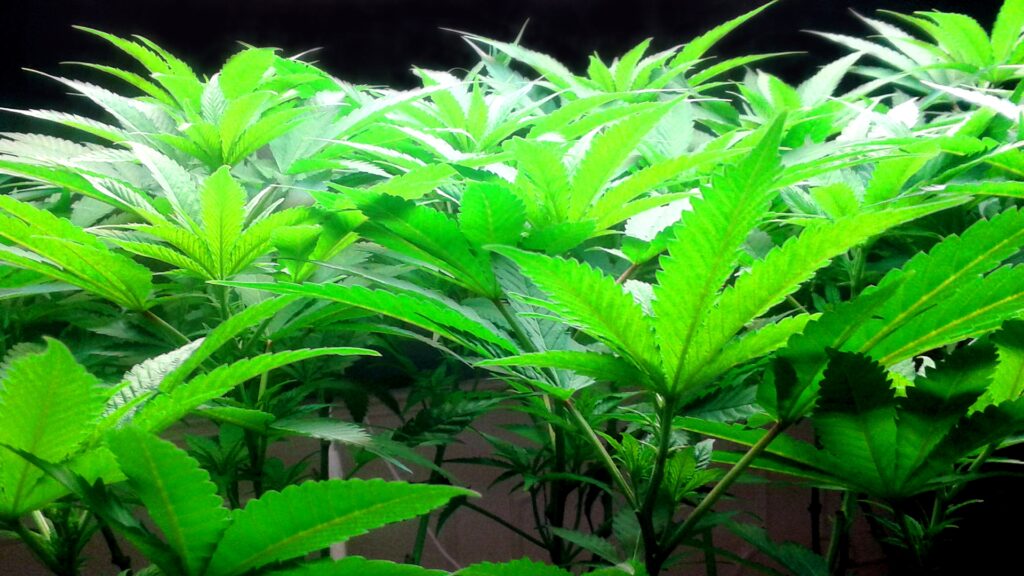
Healthy clone’s start with healthy mother plants so before I go into cloning techniques, I want to talk a little about caring for mum. UK shout-out. 😉 I prefer my mom’s to be short and wide with thick stalks just like my flowering plants. I’m not as aggressive with my mother’s because they will not hold bud weight. The technique is the same whether I’m growing a mother plant with a certain number of branches to produce a certain number of clone’s or a flowering plant with a certain number of branches that will fill a space with bud. Timing is crucial and I’ll bring it up often. Mother plant’s don’t need much. If you’re Real DGC you’ve heard the steak and potatoes analogy in term’s of mineral nutrition. In terms of the plant as a whole I think of light being the steak, the environment being the potatoes, and the nutrients are actually the vitamins and minerals we feed the root system. Mothers need a light to grow that can be kept close with low heat so the branches don’t stretch or stress from heat. Fluorescents and leds are very popular choices for mothers and clones. Large scale mothering operation’s and growers with a few lights that need to be multipurposed might go the High Intensity Discharge (HID) lighting route for coverage or it’s all they’ve got. HID lights like metal halides (MH) are more popular than high pressure sodium (HPS) lighting for mothers because plants tend to form tighter internodal spacing under the cooler blue color temperature and tend to stretch more under the warmer orange light of HPS. I want a full spectrum personally that has a little more blue (4500-6400k) in the vegetative state and a little warmer (3000-4500k) in the flowering state. Color temperature is measured in Kelvin (K). The warmer the light source then lower the kelvin number. I think the perfect all around light indoors is about 4000-4500k if I could only have one for everything. We want to blast our flowering plants with light unlike our cuts that we do not want to blast with intensity. If your light is too intense, the cut’s will really want to lay over. I keep a T12 two tube fixture damn near touching the dome and a two tube T5 about 10″ above dome. LED’s will vary depending on diodes used. Most low watt led’s can be 6″ or so away from dome. HID’s need to be 24″ plus depending on wattage.
My six tube T5 fixture’s have staggered cool and warm tubes for a nice spectrum over my mother plants. Two 54 watt tubes can easily cover 3 domes full of clones.

Feeding mothers a nice balanced diet with an even N-P-K is a good choice that’ll help clone’s root fast. In the simplest explanation (N) Nitrogen aid’s in leaf and stem growth, (P) Phosphorous aid’s in root and bud formation, and (K) Potassium aids in the overall health and the plants immune system. We don’t want to pump our mothers full of nitrogen before the cloning process or ever really because we don’t want to promote leaf and stem growth – we want roots. Something to keep in mind when growing a mother plant. If you don’t need clones weekly I don’t see a reason to speed up any of the plant’s processes. Tight and sturdy is my goal.
This young seedling could become a mother if she survives my pheno hunt cut. She’s 8″ tall split to 8 main branches right now. Getting pretty thick stem’s too.
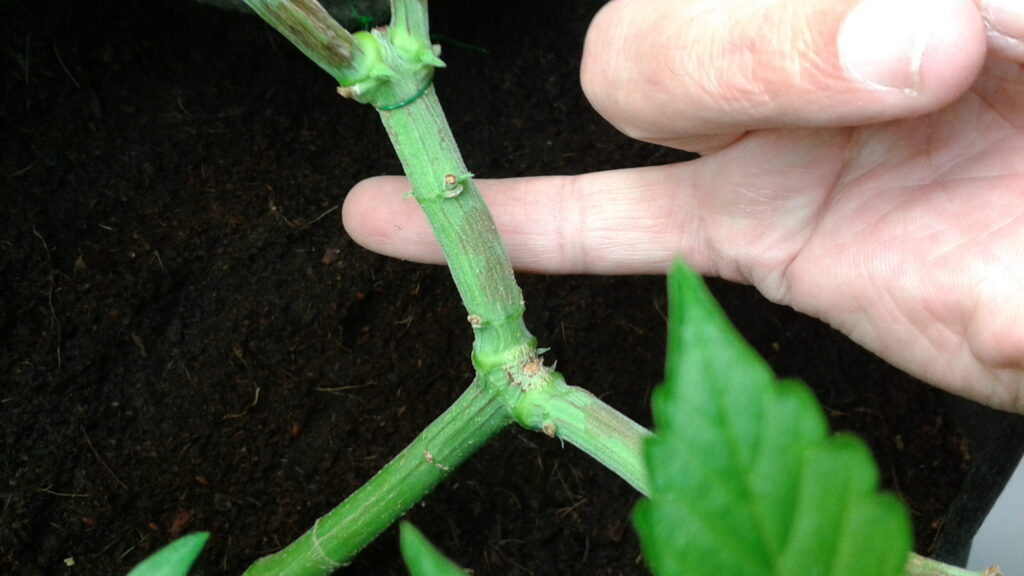
Young seedling mother’s before pheno hunt round 2. The three plants of eight that made it out of pheno hunt round 1 are in the front row. Round 2 will have 8 clones off each plant for the next test. Before the chop.
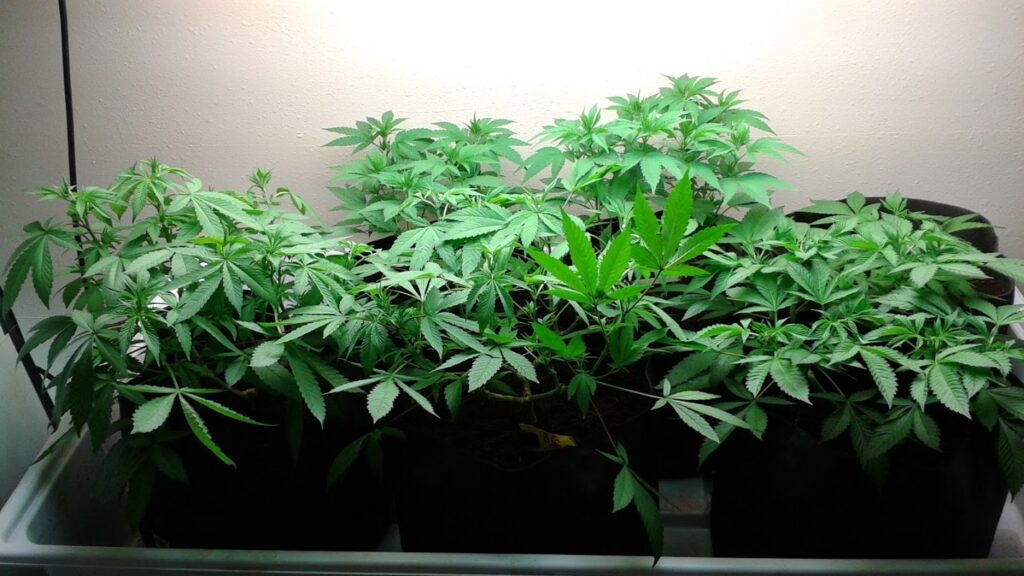
After the chop.
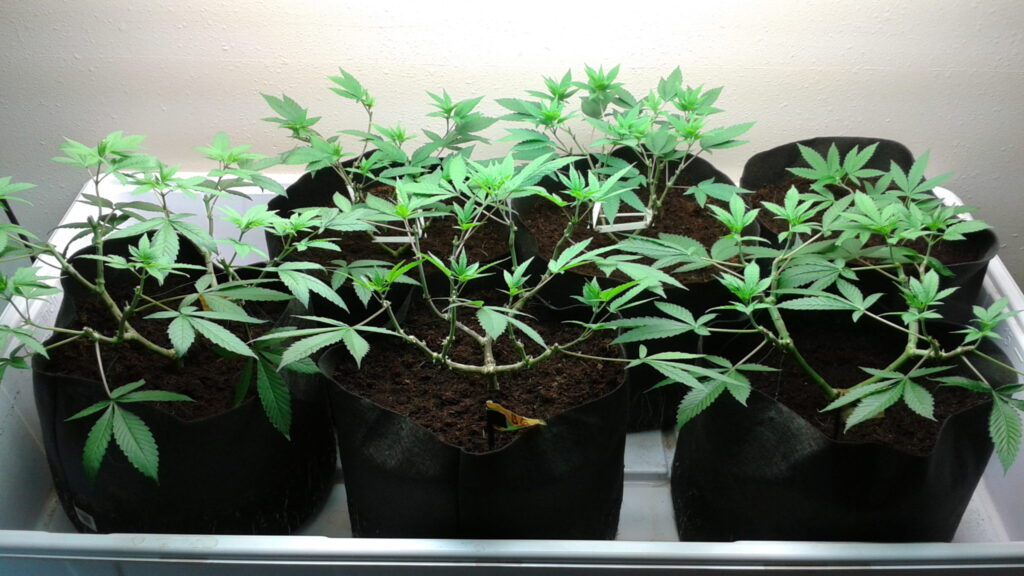
It was a close shave keeping the branch sites on this plant after cloning. Tight and sturdy at all costs. lol
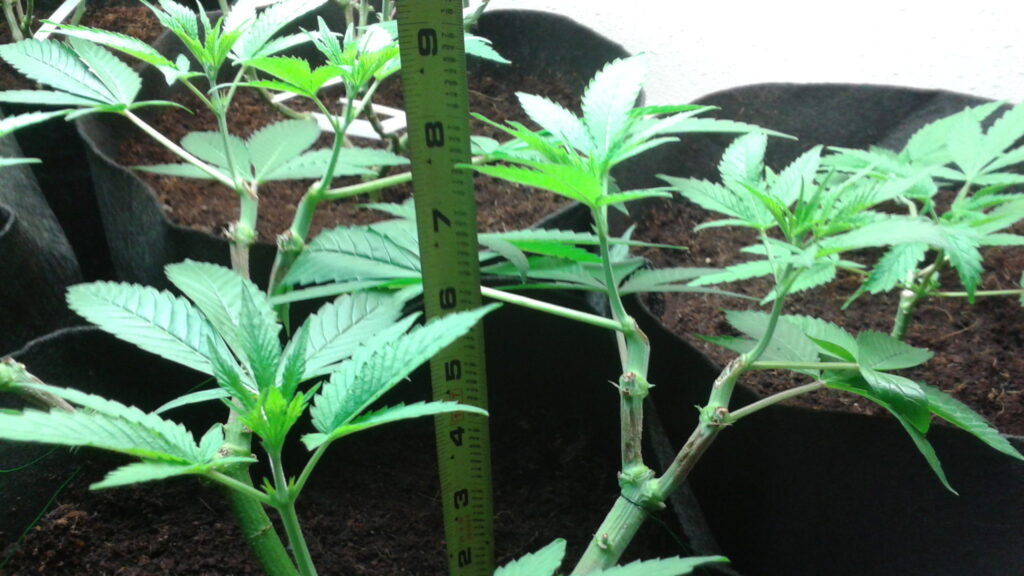
The process of cloning is a fairly simple one. I will note that I like to do it early morning. I probably read some plant science article years ago about cloning that mentioned doing it at first light that probably has just become habit. It probably really doesn’t matter when you make cuts. But before we make our first cut we must first always remember to clean and sterilize all tools and wash our hands before starting. I soak my tools in alcohol and wash my hands with soap. I use scissors to make cuts and trim leaf tips so it needs to be razor sharp (or use a razor) to make clean cuts that don’t crush the stem. This means I have to make damn sure I scrap them good before/after each time I use them before I put them in the alcohol to soak.
Some of the things I use when cloning.
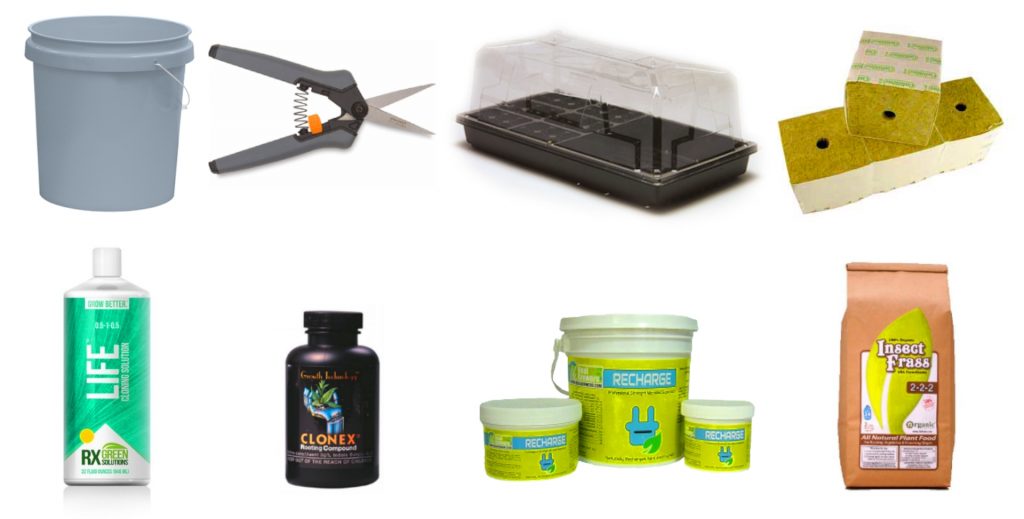
First thing I do is grab my trusty 5 gallon bucket. If you’re cloning aeroponically then only some of the next few steps will pertain to your situation. Depending on how many clones I’m going to make will determine how much it’s filled. I use rockwool starter cubes so they’ll get a soak in the bucket but not before I mix a foliar. Rockwool will clog a sprayer quick. In the bucket I will initially add 1-2 ml per gallon of a light nutrient solution (I love Grow More’s 5-10-40 bloom blast), a pinch of Recharge, and 5-10 ml per gallon of a wetting agent like Optic Foliar’s Transport. I stir it up real good then fill my spray bottle/s. I will then mix one separate spray bottle with this mix. Initially and about 3-4 day’s later I’ll spray them with this mix that has a little more kelp. I’ll explain why later. Once my spray bottles are filled then I can add a few things for the cubes to soak up that I don’t want sprayed on the clones. I’ll add 1 tablespoon per gallon of insect frass, a few drops of indole-butyric acid (IBA) rooting hormone, and 2 ml per gallon of Recharge. I mix it real good, add an air pump/stone or O2 Grow, and let it brew for about 2-4 hours with the cubes in soaking. If this mix is going in a clone machine then you’ll need to change it regularly (every 3 days) if adding biologicals like in Recharge.

I seen a cat on the internet one too many time’s. Here’s one more meow. 😉
I have not brought up potential hydrogen (ph) yet because I want to go over it a bit. Basically the acid to alkaline scale goes from 0 to 14 with 0 being most acidic, 7 being neutral, and 14 being most alkaline. Cannabis roots prefer a slightly acidic solution/medium to properly exchange ions. Depending on the medium if any will determine the best ph to ensure roots are able to absorb the minerals known as the cation-exchange capacity (CEC) pronounced cat-ion-exchange capacity alrighty meow. In layman’s terms meaning buffer between medium and roots. I’ll talk more about root structure in another article but I do want to mention a few things. Roots form differently depending on the medium. Seedlings have a tap root with feeder roots that come off it to collect minerals. The ion exchange only happens at the tip of the feeders. Clone’s have many tap roots with feeders off each. The feeder roots form differently because of the different environments they live in. In an amended soil or living soil the feeders need to be long to search out minerals. In hydroponics roots will often form fat tap roots with short feeders because minerals are delivered like pizza. I love pizza. Hint hint Scotty.
Healthy tap root’s poppin’ out!
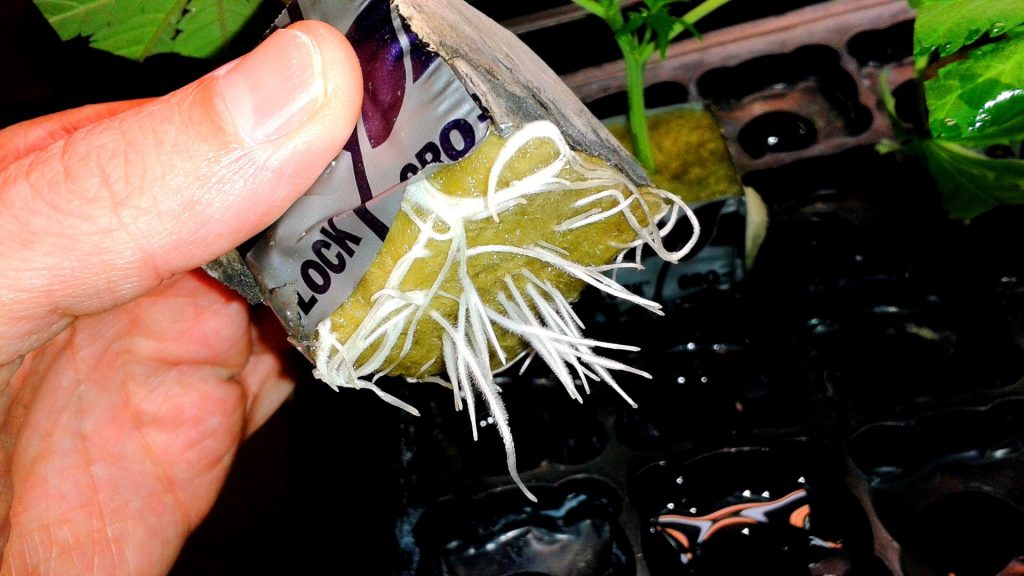
Soil has a high cec buffer and inert mediums like rockwool have a low CEC of actually zero. No buffer. This is important to know when growing and cloning so when roots do initiate, they can do their thing efficently. Using biologicals aids in this efficency. It can be important in a foliar if you are cloning in a tray like me and that overspray drips down wetting the medium possibly affecting ph at some point. So I ph my foliars at 6.0. I want my rockwool cubes ph to be at 6.0. In an inert medium 6.0 is boss for root growth. My initial ph in my bucket will be around 5.5 to start and as the neutral cubes soak in it a few hours the rockwool’s buffer lowers from 7.0 to 6.0 before I put my cuts in them. Cloning in soil? Ph is not much of a concern for you unless your source water is high and the bennies are not established yet. Understanding the different ph’s the minerals are best absorbed at will ensure victory. Nitrogren is best absorbed at a little lower ph and phosphorous is best absorbed at a little higher ph. I’ll briefly explain the three types of grows. 100% salt based with no biologicals, salt/organic mix with biological aid, and 100% biological. 100% salt based needs a ph range of 5.5 to 6.0 to get the N in early and finish with the P. Keeping it 5.8 start to finish will work great but raising it throughout the weeks will bring your garden over the top. In coco with a slightly higher CEC than rockwool you want to start at 5.8 and finish at about 6.3 for best results depending on the chelation of your nutrients. Most know that soil is fine neutral but if you start at 6.5 and finish at 6.8 you’ll have the most amazing organic garden. I bring all this up so everyone will know what ph to use in their foliars and mediums depending on their situation.
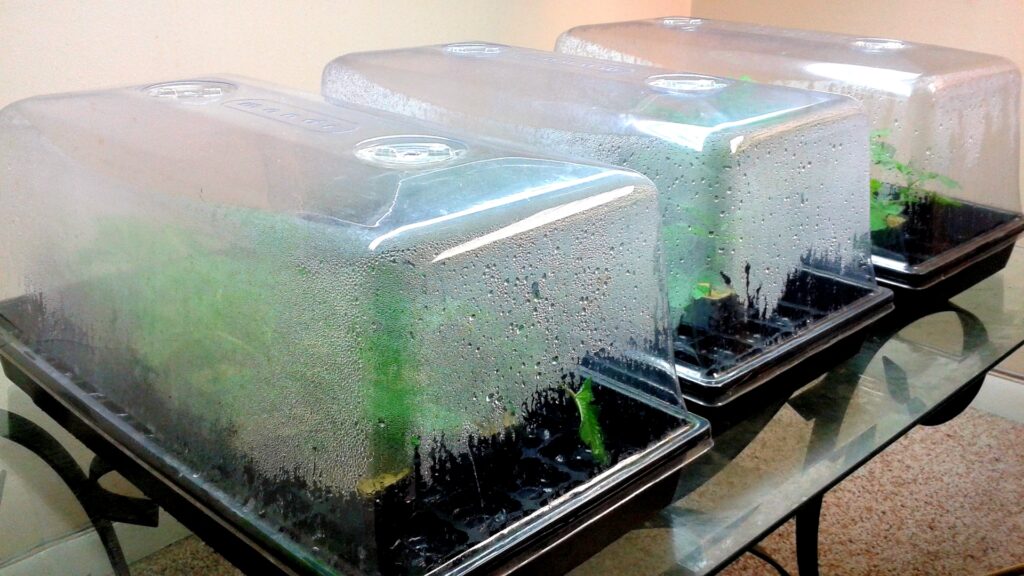
Before my cubes are pulled out of the bucket I want to prepare my humidity dome/s for the clones arrival. It’s a good idea to build up some humidity in there especially if you’re a law abiding citizen like J.R. Tokin and clone one cut in a tray all by itself because of some plant count rules. I have cube inserts used to raise the rockwool cube up off the tray floor. Use anything really to get the medium off the tray floor if adding water to tray bottom. No need to add any nutrients. A thin film of water on the trays base will raise the humidity in the dome to perfect within minutes at 75 to 80 degrees F. Never leave a medium sitting in water is why I use the inserts and I’ll explain more on that later. Now that my rockwool cubes have been soaking a few hours and I know the ph buffer is where I want it, I’ll pull each one out slightly tilting it and giving it a gentle squeeze. Once the stream of solution becomes a drip stop.
Gently squeeze out the excess moisture.
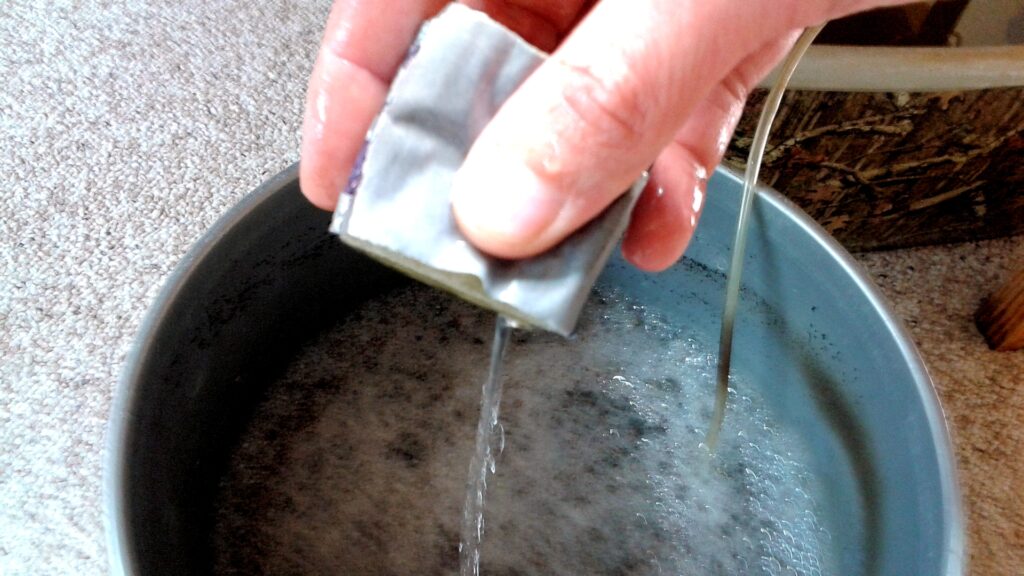
Once you see the medium start to drip go ahead and stop.

We want even moisture in the medium. Careful not to squeeze too hard and crush the medium limiting the amount of oxygen it can hold. Roots need moisture and oxygen to survive at all times while the plant’s vegetative matter needs carbon dioxide (CO2) for photosynthesis. Over-saturated mediums will not promote fast root growth. Roots like a semi-dry environment to thrive. They’ll search for moisture and minerals if it’s not delivered like pizza. After you stick your cut in a media, any media, DO NOT water the media until roots are popping out. Roots will take weeks to form if you add water to media every few days thinking you’re helping. I put the cubes in the tray, put on the dome with the vents slightly cracked and then wait about one hour until I see condensation on the dome walls before taking cuts. NEVER completely seal the dome vents.

There needs to be a slight air exchange to create the perfect environment. Depending on the light source and how close it is to the dome’s top will affect things greatly. Worse case with dome vent closed and light source too hot, the clones get cooked in minutes. Wilt. Ambient room temperature is 75 F but with radiant heat from light and no air exchange causes temperature in dome to hit over 90 F in a few hours. Wilt. Even if room humidity is 20% in CO, with water on tray floor and with the dome vents slightly cracked you’ll have perfect 90% humidity in there. Word! 😉
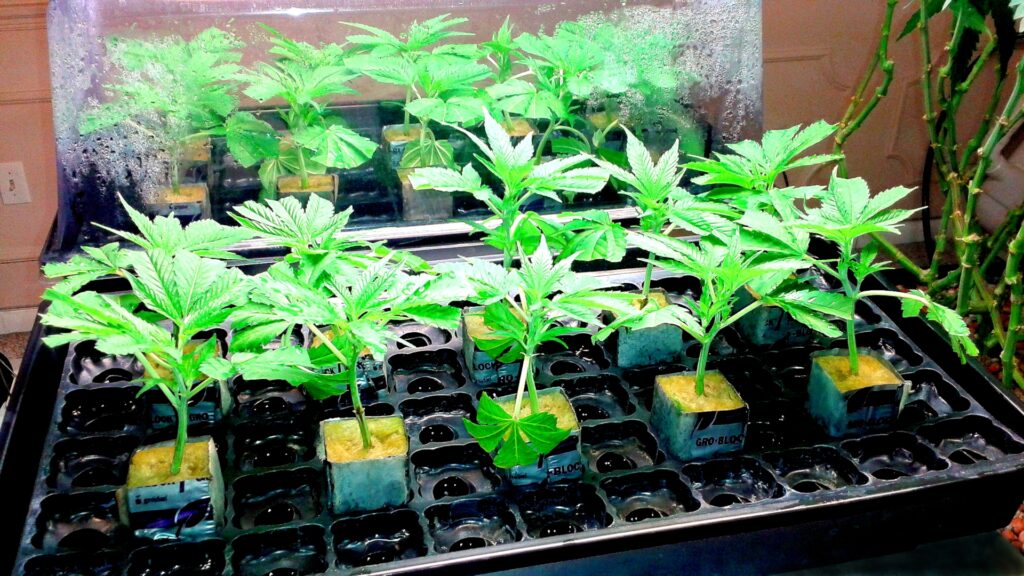

Now it’s time to take some cuts. All the prep work we’ve done up to this point will ensure the cuttings experience the least amount of stress as possible. A quick list of tools i use are as follows. Clean sharp scissors/razor, a spare GH pH test kit plastic tube filled with rooting hormone (IBA), a trash bag for trim, paper towel/s for cleaning blades in between cuts, and some clean hands. This cut came from the top of a young seedling in need of some calcium. See the hollow stem in the picture above? Healthy plants don’t have hollow stems. This is a sign of a calcium deficiency from not enough calcium or not enough trace elements that aid in calciums uptake like boron and manganese for example. Calcium relies on several trace elements because it is not a mobile mineral. Mobile minerals like nitrogen can be stored in a leaf and then transferred to more important growth later if needed.
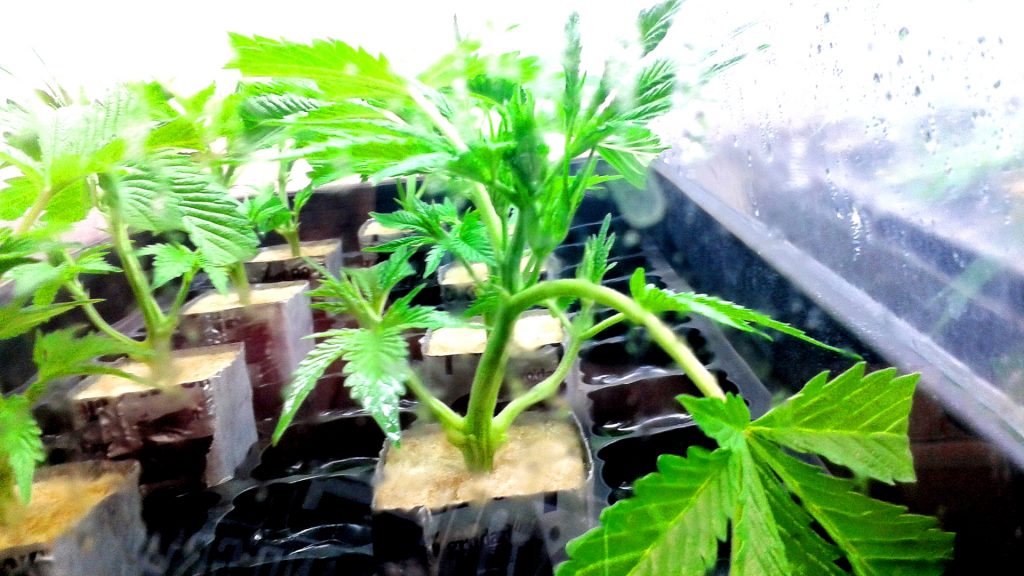
I like to grow all my plants tight and sturdy so I split the main stalk asap. The clones I make don’t need to be tall. I want thick stalks to start. Once they are rooted I want to cut the main stalk just above two new branch site’s above their node. Hopefully two are close together. The example below is from a seedling that has very symmetrical branch sites directly across from each other. Unfortunately experienced growers know this tends to go away in cloned generations causing the branch sites to stagger up the branch. We want to limit that spacing between branches (bud sites) known as internodal spacing. When I make my cut below a node at an angle for more surface area for roots to initiate from while also hoping for at least one or two branch sites to be stripped clean for roots to grow from also. Any wound can grow roots. Don’t leave anything behind to rot like the spurs. cut it all off. If you have a long stem with long node spacing and can’t get a node under the medium without a 6″ bare stem, then you can scrap the stem’s cell walls (skin) making spots for roots to form. Make sure not to leave any scraped material to rot.

After I make my cut and strip off all unwanted material for roots to initiate from, I’ll then trim the leaf tips off the large leaves. This helps in several ways. Cutting the leaf tips lowers the weight of the leaf reducing stress on the plant to hold it up, it make’s more room in the dome for better spacing (leaves can cover heads of other clones blocking their light packed in), and limits transpiration. Leaves transpire moisture through stomata on the leaf surface so less leaf equals less water loss in cut. I’ll then dip the cut in my plastic IBA filled tube and stick it in the rockwool cube until I feel a little resistance from the tip going into the rockwool. Don’t want to press too hard and poke out the bottom. This brings up something very important. The wounds we made on the cutting where we want roots to initiate from could heal if exposed to low humidity. Make sure the stalk comes in good contact with the medium.

If the hole is bigger than the stem then gently press down on the medium around the stalk so it makes good contact. We don’t want that stem’s wounds to heal where we want roots. If this is the case and you’re making more than one clone, wait until all clones are made before doing this. If you do, you might not get the hormone off your fingers before touching another cut’s leaves and you could be sorry. IBA and leaf don’t mix. I keep the dome on the tray until just before I dip the cut in IBA, then quickly stick the cut in the cube. This is a good time to bring up my foliar again. I actually have 3 separate bottles. One with plain 6.0 water with some Cal/mag, one with mainly light npk, and one with light npk and kelp (ascophyllum nodosum). While I’m making my cuts I’m just spraying water on them at this point if I spray anything. Most situations in a dome do not require any foliar spraying. You do not want water drops soaking apical meristems (tops).

Every cut gets a spray of water before the dome goes back on. I repeat this process until I have all the cuts I want. I will then spray them all with the kelp mix once they are all in their spots. If you are not using a wetting agent you can spray the clones once or twice a day for the first three days until they “harden off”. The stems should start to firm up and not want to flop over. The first three days the cut will be soft if it was taken off new growth. If it’s a cut from an older lower branch that’s “woody”, then it should stand tall. Older scraggly side branches from side branches is not the kind of start I’m looking for. You get out what you put in. I only clone from branch tops. I grow only the number of branches as I need clones on my mothers. All energy goes to grow my cuts. 😉 If you do have tall cuts that want to lay down until they harden off you can use braces.
Braces can be used for spacing purposes also. I cut pieces of plastic zip ties to make these. I’ll tie the branches down later as they get a little longer.
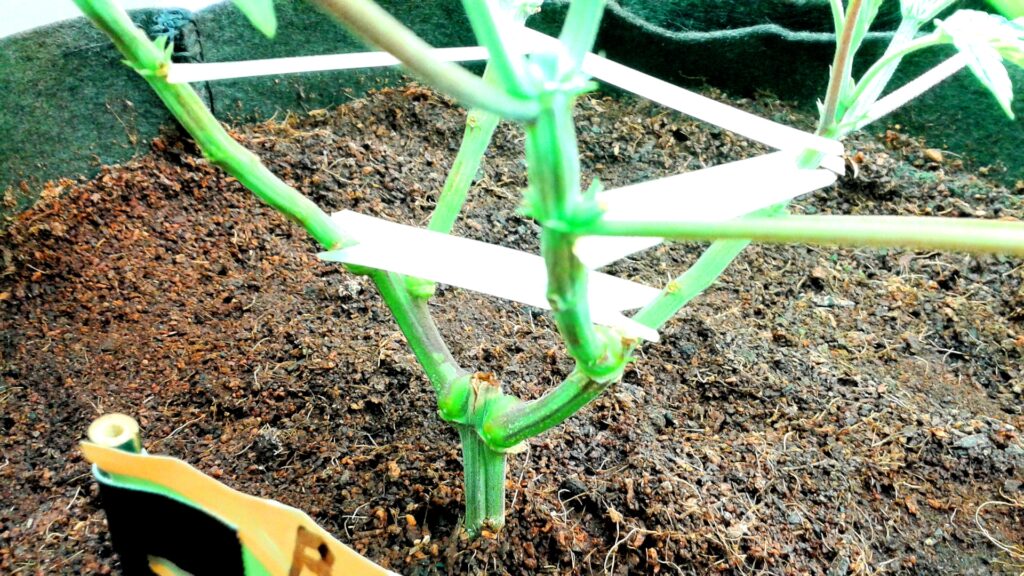
I’ve made them out of all kinds of things but I’m really liking this green wire. I can twist it to create a round bottom that slides in between the cube and cube sleeve and the other end forks up to support any part of the plant. Bend it as needed. No need for bent stems. After a few days you should remove the braces because water could sit on it causing rot where the brace touches the plant if left on over a week.
I use wire braces to hold up tall clone’s that want to lay over to keep their stems straight until they harden off after a few days in the dome. Flexible.
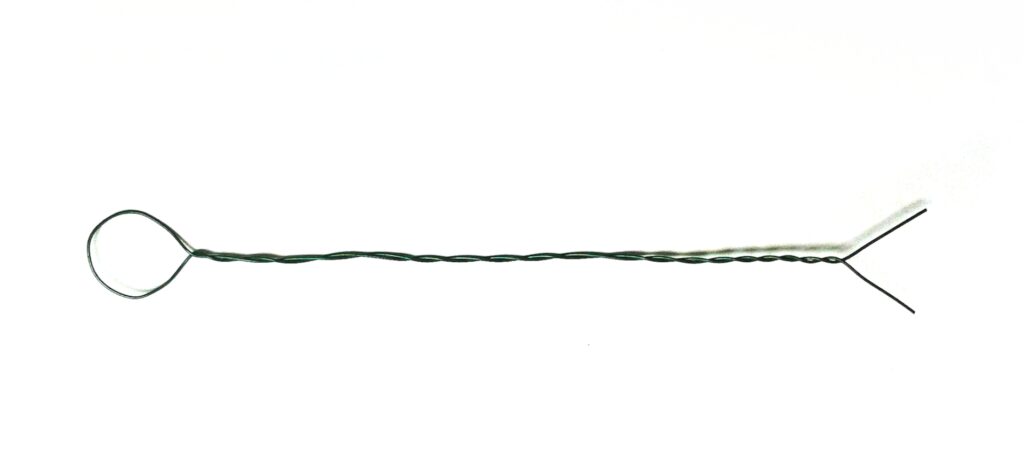
Ok what to spray and when to spray it. Get a good sprayer with a fine mist. You do not want puddles of water/solution sitting in the “bowl” of the new growth. This is especially important with any npk and kelp hormones. Hormones left sitting too long on new growth causes them to grow sofa king we todd ed to say the least or rot. Abnormal growth in layman’s terms. Used correctly and the hormones will aid in root formation. Kelp is not needed but can help for sure. I spray once a day with the npk spray just as the lights are going off at night. If I want to cool them down during the day I’ll spray them with plain water. One of the most important thing’s I can tell the new grower is the leaves do not need to stay wet all the time in the dome. Don’t feel the need to keep spraying the cuts if the leaves are not wet. If they stay wet you will have a very hard time acclimating them out of the dome at a lower humidity. Just know that we are trying to get roots fast as we acclimate the cuts to a lower humidity. As soon as they are rooted in about a week I want them already acclimated to a lower humidity. After the first three days I crack the dome vents open a little more and stop spraying at all with lights on. The idea is to start acclimating the leaves to a lower humidity soon. Make all dome vent adjustments at night and watch for stress. If after 20-30 minutes the cuts aren’t laying down your good for the night. Watch them close the next day for stress expressed in leaf curling. Humidity stress is shown similar to heat stress. The leaves will curl up on the edges and dry out. By day 5 or 6 I should see a few roots poking out. If I do, that night I’ll open the dome vents half way. The first sign of root growth can usually be seen by the base of the stem swelling a bit like a cypress tree in water even though you may not see any roots popping out of the medium yet. After 7 or 8 days I should really see roots popping. At this point I want to really acclimate the leaves so I open the dome vents all the way (at night) and stop spraying anything until they are out of the dome. I make extras but they all should be ready after ten days to be transplanted. One or two might take 10 days to show and those get culled. About day 8 or 9 to acclimate them further I’ll place bamboo in between the dome and tray creating a gap around the tray/dome letting in more air during the dark period. My mother/clone room stays 75-80 F at around 60% humidity +/- 5%. If your room temperature doesn’t stay below 68 F more than a few hours a day/night, then you should never need a heat mat. I’ve never used one before and my room in the winter can get to 65 F during dark cycle. I’d like to get the cuts used to 65%-70% humidity in the dome before removing them.
Just as happy and green coming out as they were going in.

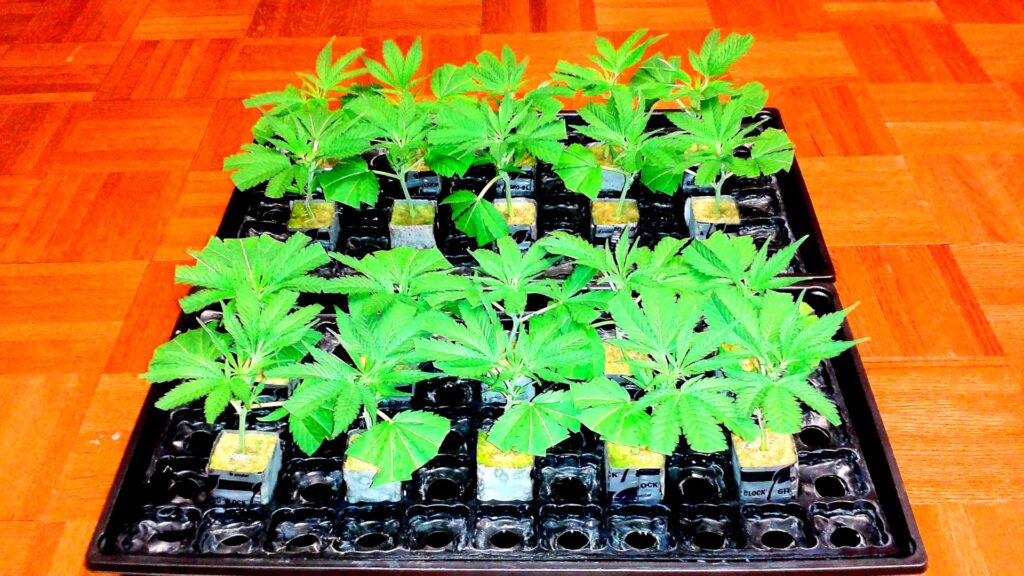
Time to transplant and put The Recharge on…again !!!
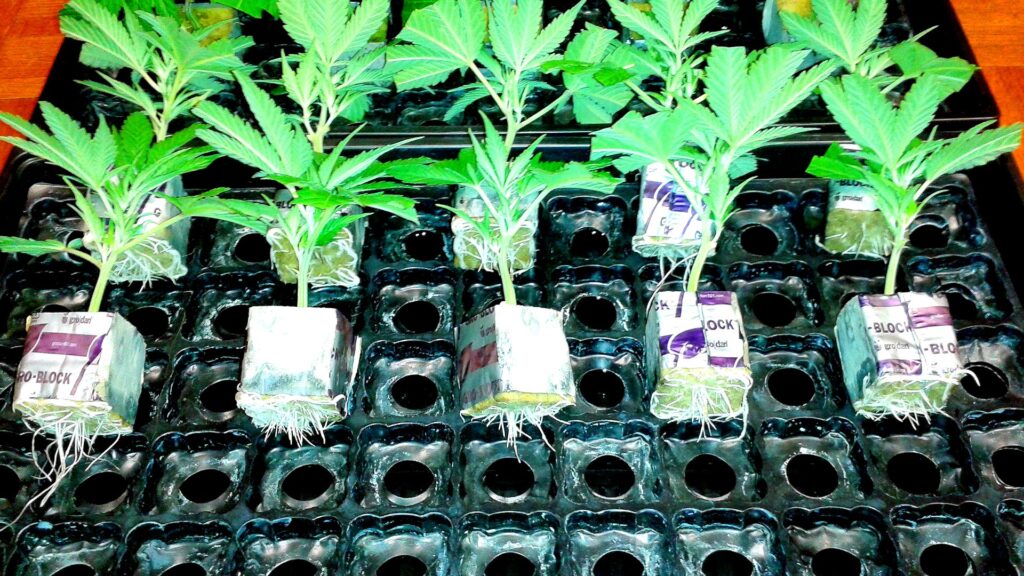
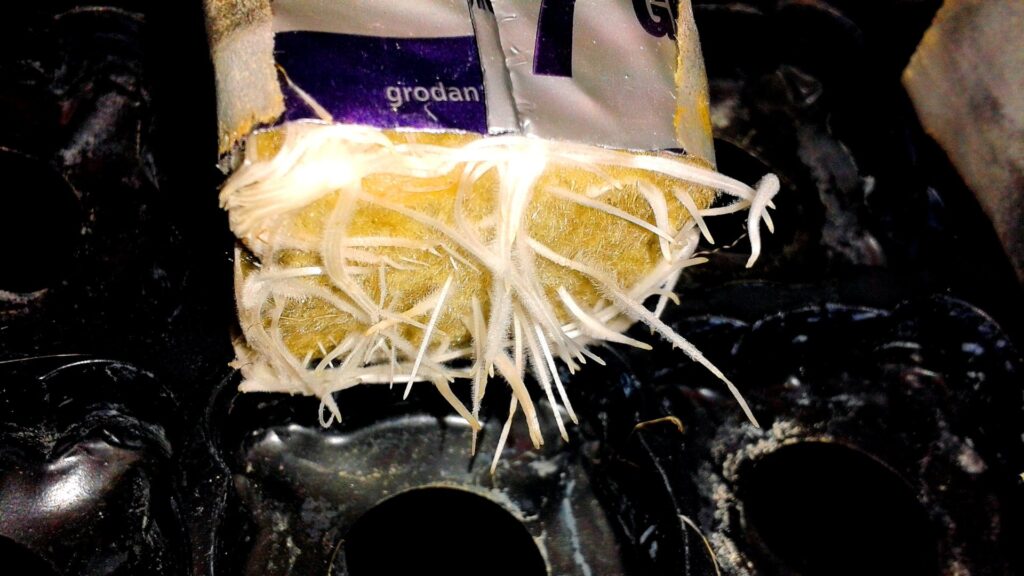
As soon as I see root’s that look like the above picture I want to transplant them. If I had to leave them in the tray with a little nutrient on the bottom they would be ok if it was oxygenated. If it wasn’t, the root’s would have moisture but not enough oxygen and start to suffocate. They express this visually as thinning. They should thicken as they grow not grow thin tap roots. Some plants are tough and are not affected by small humidity swings and some will wilt leaves after a 5% change. I can’t tell you the perfect temperature and humidity your plant prefers. You have to grow it a while to learn those things. Rushing to acclimate the clones is where I think most who have trouble go wrong. The end goal is to have the clones looking as good or better going out of the dome than the cuts going into the dome. Keeping your room around 80 F is best I’ve found with most strains. For the first 3 to 4 days out of the dome I will not put a single fan on in the room until I know they have toughened up a bit. Then they are going to catch a beating. 😉 before I end this I do want to touch a little more on aeroponic cloners. I have used them and I’ve also made my own hybrid cloners if need be.
I made this cloner out of an old Canna 5L jug. I made these clone’s to become mom’s. I cut the jug’s pattern out on a thick piece of styrofoam I had laying around so I could slide the jug in and seal a dome over it. After the cuts rooted I turned this thing into a water culture setup for a few days. Another day in it and I would of had trouble untangling the roots.
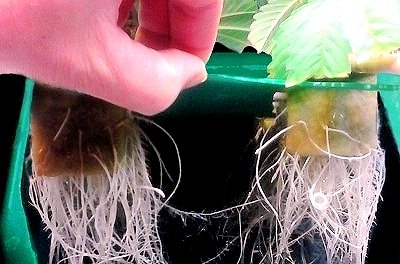
I count every watt I use and it’s hard to justify spending money running a water pump on a cycle timer and/or air pumps, etc. I will say if you are using one, spend the money on a good digital cycle timer for best results. Young cut’s can be misted for a few seconds every few hours and full grown plants in a system like this could be fed for 5 seconds every five minutes. If you constantly spray the stem early on, roots will not form quickly. Well DGC I think that about explains most of what i do to make babies. If you have any question’s just ask. Growers <3
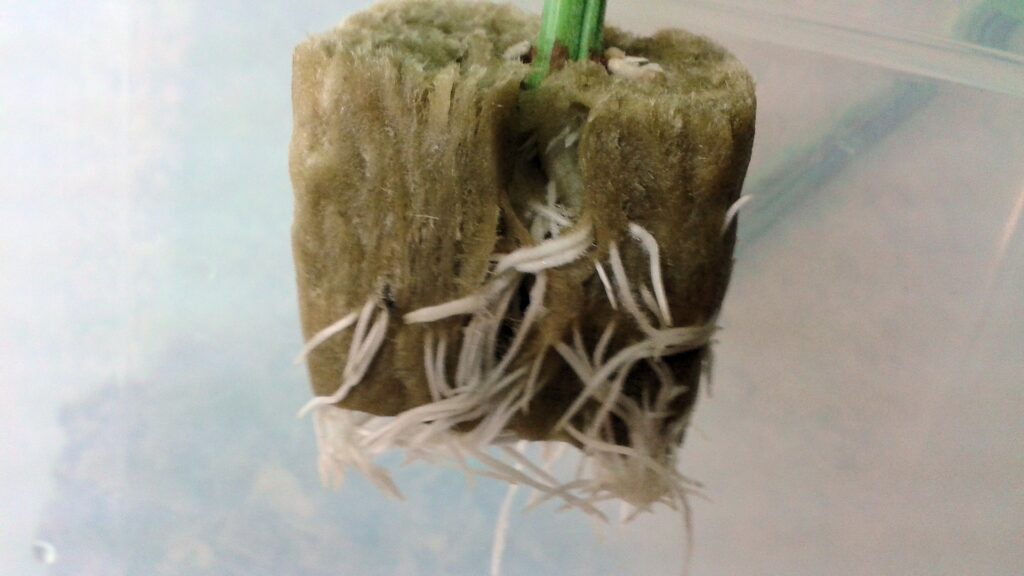
Great Article Jmystro. Good read. I’ll have to read through it a few times.
After reading again I have picked up a lot of necessary info. Thanks for putting in the time to write down and share your knowledge. I’m sure there are a lot of us that will pick something up from this article. I’ll will more than likely pick up more as I go back and make some personal notes. The monkey is badass bro.
Thank’s Tony. I was pretty high when I wrote it. I’m no writer. I hope there’s not too many grammar errors. lol
Mystro, great article. I was thinking about writing a cloning article but you hit everything. You are really kicking it up a notch! Aside from the ‘s I see very few grammar errors! Only use the ‘ if something is possessive (the plant’s vegetative matter), or in a contraction, like “you are = you’re”. If a word is plural, the ‘ doesn’t go in. Try not to confuse us stoners. ROFL.
I don’t do as well with thick / hollow stemmed clones like you’ve taken, but man they look great! I’ll try some thicker ones next time.
I read it twice! First time I skimmed through it, couldn’t focus. Second time I read it, I was prepared. Had my note book, different colored pens, highlighters and coffee only. It gave me a feeling of middle school science class. Dissecting a frog, only day I made it to school early.
-Thank’s Capn for the tips and the confidence. I’m new to putting my thought’s down in an articulate fashion. Derp. Most of my writing is just rants full of cuss words. lol. I tried my best to keep it clean and to the point without rambling on forever.
– Blue Aztec you’ve made my night. Not for one second during my writing did I think anyone would care enough to take notes and highlight. That’s fucking badass bro.
Dam good article. Even picked up a few tips to play with.
Love this info Mr.Mystro Tons of valuable information on cloning!! Giving me more ways to use that frass and my recharge!! Thanks for all the awesome tips jmystro keep them coming! Oh ya still waiting for a video lol
Thanks for taking us to clone school Jmystro. I’ll try it with my feminized.
So according to your chart, if I mix Coca-Cola and bleach I can have a nice neutral drink.
Seriously though, thank you, I’m putting this into my digital notes.
Now that I have some Mammoth P I’ll be using it in my next round of clones. One more biological aid to compliment the Recharge and Insect Frass. Phosphorous specific microbes sounds like win win. I can see the roots forming now and upon hitting the rockwool I can see these microbes holding up signs saying welcome to Las Vegas, now go party.
Great article… bit long though ;P
Great article brother. Lots of great information. It also made me realize how basic my method is. Dyna grow KLN, rock wool cube, humidity dome and a heat mat if needed. I think next time I’ll. try some of your methods and compare results.
Nice! The only thing I would dispute is that I do run organic and I use aloe and I bang out 100% as well. I think it just about having the environment right. Although the way your doing it youre seeing roots much quicker. Very good read and great knowlwdge and im going start using some of this stuff. Never though of using the frazz that way. Thanks for posting
Thank’s Mike,
I have a hard time guaranteeing anything in growing but you’re right about cloning all naturally with success. With enough patience damn near anything is possible. Most people however are not patient and want the fastest way to do something.
Hell yeah now I know everything I’ve been doing is wrong. No wonder I can’t clone stuff. Thanks j
Great article. Defiantly worth the read over and over.
Holy shit that was cloning 101 at its best oh J did it agin!!!???? and Tony’s right I got to read this shit one more time. Have a good post keep them coming Mystro.
Great article! Love it…thanks for taking the time to make it. Very informative.
Mystro this is awesome! even a noob dumbass like myself can follow these simple step by step instructions.
Please continue to share your Best Practice’s (that was for you mr. real)
the best thing that ever happened to my ability to grow good meds was to be turned on to the DGC and its awesome members like yourself.
Thanks Jmystro!! Detailed and concise. I’ve read several times now and have picked up more than just cloning! Definitely a permanent part of my “Grow Knowledge” Library. Appreciate all your hard work and sharing it with the DGC!
Hey keep reading this and its a great read and has made me try some new things! Question …has anyone tried foliar feeding with a bloom boost on clones. I have heard of people using general organics bio bud at a light rate and because of high phosphorus it helps root quicker. Any thoughts or has anyone tried this?
Hell ya good read! I like to see clones come become rooted and stay ‘Just as happy and green coming out the dome as they were going in’ but don’t sweat it if they start to yellow. Sometimes on harder to clone strains you might even have a leaf die off before roots are visable. BE PATIENT I have seen clones that looked almost dead finally shoot its roots. Not ideal, but it can happen. Thanks Mystro
very informative, good job man!
Awesome article Mystro!! I definitely an glad you gave valuable cloning instructions. I would like to add a couple bits and would like your opinion.
1. When taking my cuts off the tree I have my bucket next to me with cal/mag, Rx cloning solution and recharge then ph to 6.0. After taking my cut it goes into the bucket stem first if it goes under its ok but I try to keep them vertical. I do this in the idea of getting the all goodness into the cut and the clone. This is to insure that the clone gets a quick drink after leaving the mother. My next cut on the stem with a sterile razor blade, then used clonex gel. I have found the rapid rooters works better for me and I can get roots 4-7 days Your thoughts.
2. I also place my rapid rooters in the bucket solution before I use it to place my clones to get that drink before my second cut then into the rapid rooters. Pretty much very close to your method thanks again for sharing your method.
Hello Big Matt,
I don’t see any issues with dippin’ the cuts as long as the solution ppm isn’t too high. I think if you keep happy mother plants your cuts should do just fine without. I personally like to get the cut under the dome asap.
I posted 2 picks on the Google plus page of the crazy frosty/hairy roots. Great advice thanks bro!
Seriously one of if not THE best tutorial on cloning!
I can go everyting but the Recharge. It jumps the ph to high.
Hey Michigan many inputs will affect ph. I use a yucca extract not just as a surfactant but also as my ph down and the Life Cloning Solution is acidic as fuck also. My source water has a ph of 8.5 and I rarely need to use any ph down because most of my inputs are very acidic and some are alkaline like Rhizotonic and Recharge.
Nice article Bro
hey mystro I just made my account! I wish I could afford to donate $10 a month which I know is nothing it sounds lame but I live in San Diego for some reason. anyways I was just reading through articles and I just got done cloning for my like 4th or 5th time however I only got about 75% success. im defnitley going to try this method step by step and see how I do. im not doing much different im just using different products or missing one a product here and there like the life solution. im going to order some of that off here before I give cloning another go. thanks for this great article!
BTW this is Kyle MasterKushman lol
Thanks Kyle. The cuts environment is one of the most important variables in rooting success. Good luck bro.
Once again great content thanks j mystro
awesome shit bro,,,appreciate the love for the information…free source info is the way to go an grow bro,,much love from my way
Great read Jay, I’ve learned from reading your (writings,) timing & patience is very important when growing from seed or taking cuts to root. I’ve slowed way down and focuse on the basics.
Thanks for posting this! I haven’t used the Life product from RX but i hear dude talking about it on the show. Have you noticed a significant difference when using it as opposed to not?
RX Green Solutions Life is a decent product for cloning. I’ve been using Grow More’s Mendocino 5-10-40 as a cube soak and foliar spray with better results.
Jmystro when I started on the website about six months ago(5 months paid) this what I learned to clone off of. You’ve helped me then and still helping me now! If I ever doubt myself this is what I run back to! Thank you for such a great article. Growerslove my friend!
You’re very welcome Soulessginger. 😉
This is the most complete cloning tutorial I have ever read. Jmystro is the man. Thank you!
This article is timeless 😉
Thanks Jmystro! The next part of my growing experience is using mothers for cloning so I was ready to spend hours of research for the next week and the first place I go is the DGC archive and Bam! You covered everything, bro!
I thoroughly enjoyed the writing and nice touch with the humor. Going to have to read this more than once for sure.
Thanks again!
Exactly what I was looking for.
Jmystro thanks for the info. I have been cloning with good success in rockwool with a dome and keep running into the issue of the root tips turning brown as they grow out from under the cubes. I have seen many other’s pics, including yours where the roots grow out like long white hairs with no brown tips.
I have read everything from them being too wet to them being too dry and air pruning themselves but I cannot dial it in. They are probably rooted enough to transplant but I just cannot get the long hair like roots coming out… what am I doing wrong?
Sorry to hear of your troubles doja.release. As soon as I see roots popping out I know I have about 2-3 days of hardening off the clones before I can transplant them out of the dome. During this hardening off period, the dome’s RH goes from about 75-80% down to about 55-65% RH. This is high enough humidity for the few days before transplant. Root tips turning brown is a sign they are dying. Roots can start to die from too low humidity. Like removing the dome for too long before transplanting them. Roots want to be in the dark. So do your best to keep light off them. I like to use tray inserts that the cubes can sit on and not have the cubes sitting in the tray bottom. Cubes sitting in a tray bottom risk soaking up any solution from spraying back in to the cubes. Roots need plenty of oxygen. An example of tips dying from not enough oxygen would be from the roots sitting in an unoxygenated solution. Like solution in the dome’s tray.
This is the best article I’ve read about cloning. Thanks so much for sharing! I was having issues with my clones all of a sudden. I was rushing some things. Thanks!
Great guide thank you cuts look amazing been having problems with mold lately be trying this method out soon do you still spray at night after day 3
Like to know how old an big the plant you takes cuttings an where you cut .do you cut a branch from the top?how long.
Thank you for this! I found multiple things I have incorrectly or not using best practices! Love the DGC!
I’ve been growing for about 5 years maybe 6 now since we went legal in Oklahoma. I grabbed a…
Ok, so I thought I had lost my touch lately on popping seeds. I’ve NEVER had issues before I’ve…
I have been watching the DGC for quite a while now, not a patreon yet but very soon! I…
What’s Growing On DGC? The Dude and Scotty are Hanging Out Talking Cannabis News, Culture and Growing. https://open.spotify.com/episode/0yS6jok54qSAap0lR9hl6P?si=ec4a2078a2724dab THIS…
Wildberry Cake got sliced
Leave a Reply
You must be logged in to post a comment.